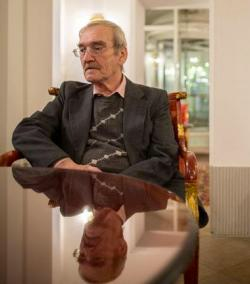There are few stories from the cold war more dramatic than that of Soviet Lieutenant Colonel Stanislav Petrov. After all, earning the nickname “the man who saved the world” doesn’t happen everyday.
But despite his heroic role in one of the most perilous U.S.-Soviet nuclear incidents, Petrov is still not a very well-known figure. A new film, also called The Man Who Saved the World and being shown in a nationwide screening day today, aims to publicize Petrov’s story, and in doing so helps to illustrate the continuing dangers posed by keeping nuclear missiles on hair-trigger alert.
A trailer for the movie is here, and a list of showings at campuses across the country is here.
A Warning of Nuclear Attack
On September 26, 1983, Petrov was the commander on duty in an early warning center, responsible for alerting Soviet leaders in the event of a U.S. attack. Shortly after midnight that night, the system warned that a Soviet satellite had detected the launch of U.S. missiles. First one, then two, and finally a total of five land-based missiles appeared to have been launched at the Soviet Union.
The warning came during a time of high tension between the two countries: the United States was in the midst of a military buildup and President Ronald Reagan had been escalating anti-Soviet rhetoric. Worse, earlier that month the Soviet Union had shot down a Korean airlines passenger plane that had strayed into its airspace, killing the almost 300 people on board.
So while the idea of an American nuclear first strike may seem absurd today, at the time it was all too believable, especially to those sitting in early warning centers, whose training taught them to look out for just such a crisis.
Colonel Petrov had only minutes to decide whether the alarms going off in the middle of the night indicated the real thing—the beginning of World War III—or a false alarm. The satellite that sent the warning seemed to be working properly, so procedure dictated that Petrov’s next move should be to report an incoming attack.
Petrov, however, had his doubts.
Given the title of the film, it shouldn’t be too much of a spoiler to reveal his decision. Based partly on “a funny feeling in [his] gut” and partly on his belief that if the United States—which had thousands of nuclear weapons—was going to start a war, it would do it with more than just five missiles, Petrov told his superiors that it was a false alarm, even though he had no data at the time to confirm this.
Petrov was subsequently questioned and criticized for his actions, with some officials trying to make him a scapegoat for the false alarm. Later investigations revealed that reflection of the sun on the tops of clouds had fooled the satellite into thinking it was detecting missile launches. While the Soviet system used an orbit designed to minimize the chances of false alarms, on that night, shortly after the autumn equinox, the early warning satellites, sun, and clouds aligned in such a way to maximize the sun’s reflection.
The film, which presents Petrov’s memories of that night in the command center and his story in the years following, is well worth seeing (and if there is no screening in your area now, stayed tuned for a forthcoming theatrical release). Disturbingly, this incident is only one of several times when early warning system errors, among other problems, increased the chances of a disastrous mistake with nuclear weapons.
While Petrov’s instincts and good judgment prevented a catastrophe in this case, if the satellite data had indicated the launch of a hundred missiles rather than five—or if a different officer had been on duty that night—the outcome could easily have been unthinkable.

